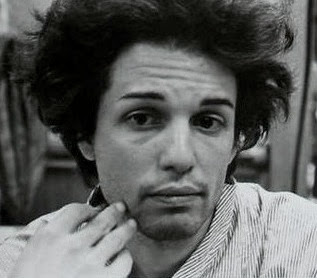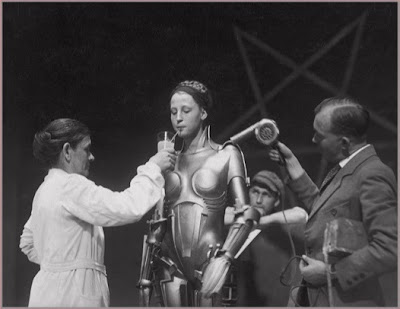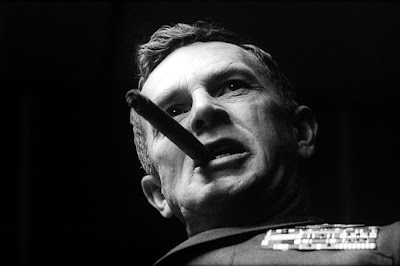Without sounding anymore like a prat, here are some chronologically arranged movie moments that have (for one reason or another) achieved immortality...
Boobies! from Inspiration (1915)
Quite simply, and according to most expert speculation, this was the first time in Hollywood history that a leading actress got her kit off in a non-pornographic role (yup, on-screen porn is as old as cinema!!). Yes, it was in fact Audrey Munson who was the first leading lady to bare all. The context was relatively innocent-she was playing an artist's life-model. Nevertheless, the statement was made....
 |
| Lil' Kim pays homage to Audrey Munson. |
The Big Entrance from Nosferatu (1922)
I considered not including this as I felt as though the film-gods were yelling 'duh' at me with the ferocity of a conservative critic. But, look, this is the moment that essentially created the 'he's behind you' horror sequence that has featured in, um, every horror film since. As a terrified Hutter cowers (rather foolishly) in the corner, the door to his chamber swings open unnaturally and Count Orlok (they did not have permission to use the name "Dracula") literally hovers in. Max Shrek's animal-like expression is priceless.
A horror legend is born! All slow-build, sudden-jump scares are the offspring of this amazing sequence. So get in line for gratitude Hitchcock, Carpenter, Craven, De Palma, and Argento! (except for Hitchcock, he is dead and cannot form a line).
Friendly competition in The Seventh Seal (1957)
Firstly, this may be the greatest film ever made. Secondly, all things considered, the image of a man playing a chess match with death in the middle of the Cold War is perhaps the best metaphor in cinema history.
So, now that all of the necessary facts are out of the way, here is the scene: Antonius Block is a Knight returning from the crusades. This man has it all, in that he is a depressed, war torn man dying of the plague. Sheesh. During a silent moment on a beach, he meets Death. A playful being, Death invites Block to join him in a chess match. Should Block lose, Death will take him and all those that he holds dear. Not cheery, but amazing. An atomic age metaphor that still feels piercingly relevant today.
Cruisin' form Easy Rider (1969)
Do you like big spokes?! Is Dennis Hopper's big bike what you see when you close your eyes?! Then you, my friend, have already been converted!
Aptly released in the same year as the first Woodstock Music and Arts festival in 1969; this true gem essentially made the American filmmaker young again. In the late 1960s the dated studio system still loomed over the business. Thus, young indie filmakers found it virtually impossible to even get a job after film school, let alone direct their own indie gem. Until, that is, a drug-riddled Peter Fonda and Dennis Hopper tore down the highway on choppers to the sound of Stepphenwolf's "Born to be Wild". With this image of rebellion, it was asserted that a new generation of indie filmmakers would define the next era and the death of the old studio system and the rise of Film Brats Spielberg, Lucas, Coppola, Milius, and De Palma to the ranks of era definers. Thank, Easy Rider!
"I'm Easy" from Nashville (1975)
(*note-this is my first time discussing my favourite movie on this blog-yipee!)
What follows is the perfect ark of an antihero: Of all the onscreen womanizers, Nashville's Tom Frank has to take home the Golden Phallus. This disgruntled folk-rock singer beds every woman he meets. Reporters, bandmates, groupies, nobody is safe from Tom's mighty trouser arsenal. But, like the great anti-heroes, there is soul beneath the gruff exterior. His true love, Lily Tomlin's middle-aged housewife Linnea Resse, eludes him. Amidst his usual sexual barrage, he invites her to a gig to woe her with a song. In a room full of women, everybody thinks Tom Frank is singing to them. This scene represents my favourite use of a song in film, as well as my favourite romantic scene. Keith Carradine won an Oscar for the original song "I'm Easy."
"An old joke..." from Annie Hall (1977)
How important is courage in making a good director great? Well, given the first Oscar win of a skinny, effeminate, Jewish New Yorker, it would seem that the answer is very. With his roots in stand-up comedy, a young(ish) Woody Allen decided to use his best asset to devastating effect in the opening scene of Annie Hall. The opening, Woody looking directly into the camera and delivering a humorous monologue may not have been new to fans of European modernists like Godard, but, for American cinema, this moment of originality marked a self-reflective turning point for American cinema.
Christopher Reeve is the first true comic book hero in Superman (1978)
If there is magic in the first time we see Christopher Reeve soar through the air in that blue and red suit, then it is to be found for the most part in the film's influence. As the world chews over Marvel's new Avenger's Assemble (2012), and obsessively awaits the ominous The Dark Knight Rises (2012), I would like to take a moment to acknowledge the movie that got the ball rolling. Tim Burton's Batman (1989) may have made the most headlines, but, with its nostalgic setting, roguish bad-guy, tentative love story, and momentous-come-tragic leading man, Richard Donner's Superman produced the formula for a phenomenon.
First-Person Horror in Halloween (1979)
For better or worse, John carpenter altered the horror craft forever with this one. Carpenter's biggest innovation, however, may not even be the slasher motif. Instead, how about the opening scene in which the camera is Michael Myers! Indeed, here is a sequence that invites us to witness murder as though we are the perpetrators. Carpenter knew that the scariest way to be introduced to the deathly Michael Myers was to briefly become him. Clever stuff.
Stuck in the Middle with irony! from Reservoir Dogs (1992)
Okay, okay, so Tarantino stole the ear-slicing moment from Sergio Corbucci's Django (1967). Nevertheless, there are moment within QT's daring heist-homaged debut film that resonate on a wholly original wavelength. Particularly, the Mr.Blonde/Marvin Nash tortue scene that seem rather revolutionary in their own right. Tarantino has often remarked on the reaction that this glib scene recieved. I feel this is the case because, in fact, this is the most famous moment at which the pop-culture reference got truly nasty. Think of how Michael Madsen moves to the melody of Stealer's Wheel. As Tarantino points out, the joy we experience as an audience in the first few moments of the scene makes us accomplices in the more gruesome parts. His deadpan glee is a true Generation-X moment. Nice steal then, Quentin.
There's always time for Coffee from Heat (1995)
They appeared together in one of cinema's great masterpieces...they just didn't get to be in the same room at the one time. Yes, for the 21 years after Godfather Part II (1974) it seemed like Al Pacino and Robert DeNiro were unstoppable in Hollywood. Evidently, the only for they didn't care to vanquish was one another. Then, alas, after two decades of waiting, there was the mother of all cafe scenes. The plot of Heat builds slowly to the face-to-face confrontation between Pacino's grizzly cop Vincent Hanna and DeNiro's ace thief Neil McCauley. Parallel to lay the fact that every self-respecting film fan knew that the scene represented the first time the pair had shared the screen. Which thespian shall rule them all? Magic.
Raining Cats and...?? from Magnolia (1999)
Of all the movies in all the world, these frogs had to drop into this. Not only did Paul Thomas Anderson prove that with his 1999 masterwork Magnolia that 1997's Boogie Nights was no fluke, he practically reinvented the filmic wheel. Set over two days in the not-so-sunny San Fernando Valley, Anderson's masterwork evokes the great ensemble pieces of Robert Altman in that it has over a dozen principle characters. It's all about fate and, Anderson says, parent-child relationships. We'll take him at his word that air-born frogs fit the aforementioned motifs.
Have a nice day!!!!
..................................................
































